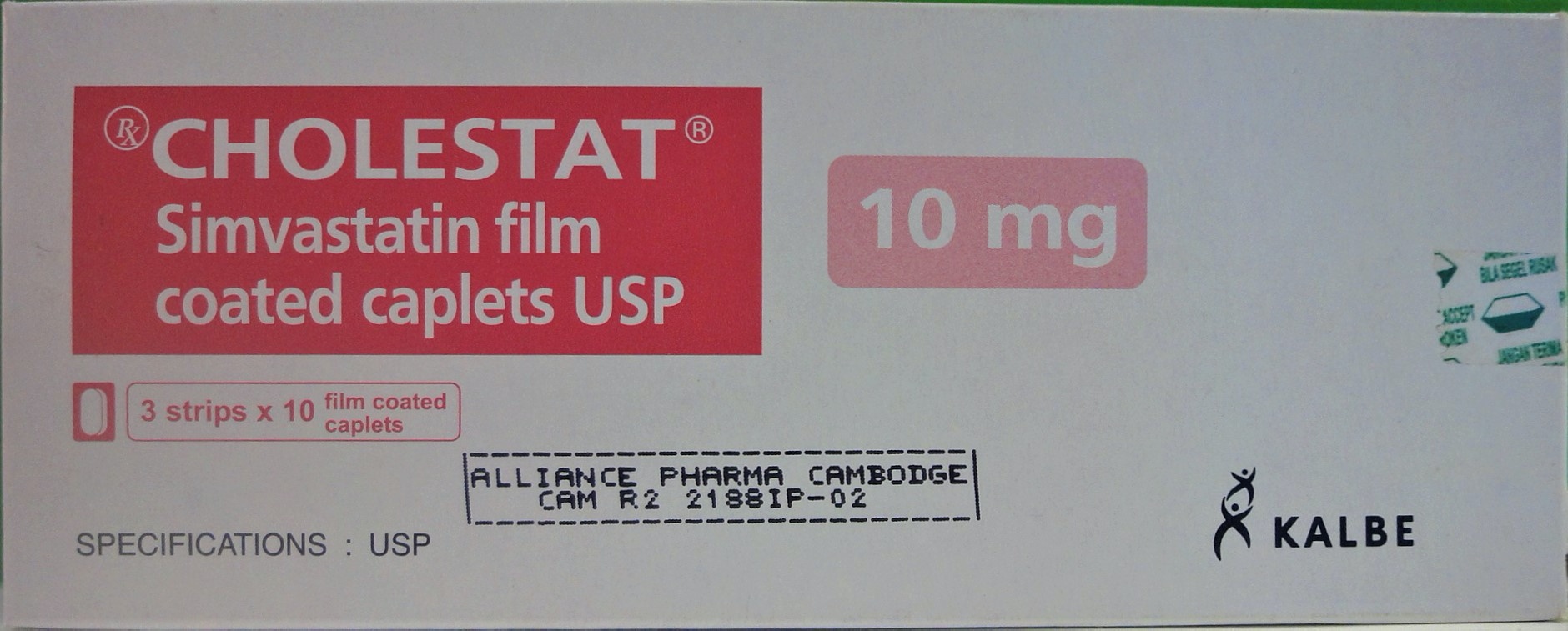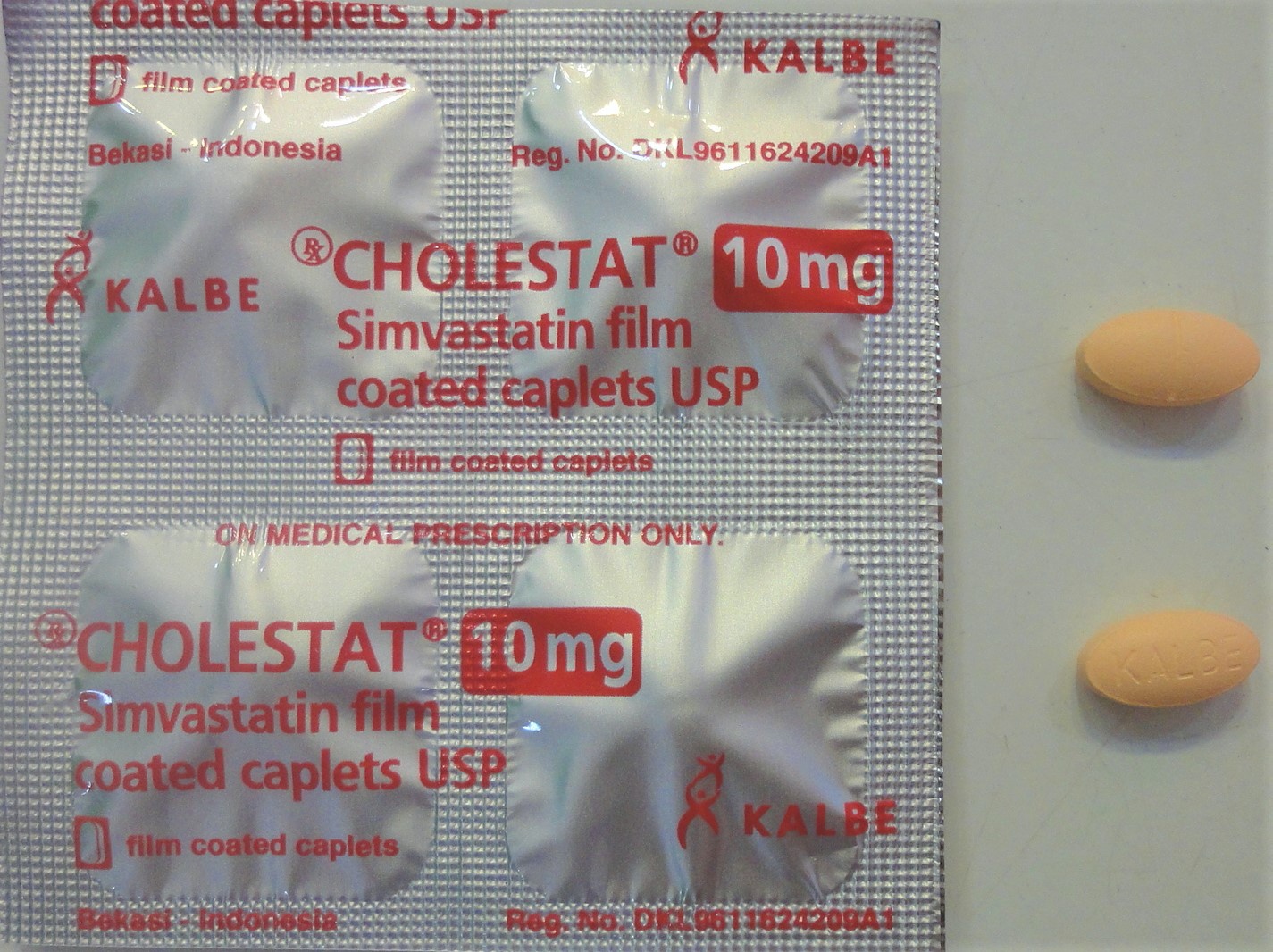CHOLESTAT Caplet
ក្រុមហ៊ុនផលិតឱសថ:
PT KALBE FARMA Tbk. Indonesia
ក្រុមហ៊ុនចែកចាយឱសថនៅប្រទេសកម្ពុជា:
ALLIANCE PHARMA CAMBODGE


- សារធាតុសកម្ម
- ប្រសិទ្ធិភាពព្យាបាល និង កម្រិតប្រើប្រាស់
- ហាមប្រើ
- ផលរំខាន
- អន្តរប្រតិកម្ម
- ការប្រុងប្រយ័ត្នជាពិសេស
- សកម្មភាពឱសថ បរិយាយប័ណ្ណឱសថ
-
សារធាតុសកម្ម
Simvastatin 10mg
-
ប្រសិទ្ធិភាពព្យាបាល និង កម្រិតប្រើប្រាស់
Indications
to reduce Total-C and LDL-C levels in primary and secondary hypercholesterolemia when diet and other non-pharmacological measures resulting inadequate response. CHOLESTAT also elevate HDL-C, therefore LDL/HDL ratio and Total-C/HDL ratio will be reduce.
Prior to initiating therapy with CHOLESTAT, secondary cause of hypercholesterolemia, such as poorly controlled diabetes mellitus, hypothyroidism, nephrotic syndrome, dysproteinemia, obstructive liver disease, other concomitant therapy, and alcoholism should be excluded and a lipid profile performed to measure Total-C, HDL-C and triglycerides.
Dosage
Patients should perform a low cholesterol diet before therapy with simvastatin is started, and the diet should be maintained during therapy. The common initial dose is 10mg/day as a single dose in the evening. Patients with mild to moderate hypercholesterolemia can be treated with an initial dose of 5mg. Dose adjustment can be made at intervals not less than 4 weeks and the maximum dose is 40mg/day as single dose in the evening. Lipid profile should be check minimally every 4 weeks and the dose adjustment is depend upon patient’s response to therapy. If LDL-C levels fall below 86mg/dl (1.94mml/l) or Total-C levels fall below 140mg/dl (3.6mml/l), the reducing dose adjustment should be considered.
Use the lowest dosage in patients receiving concomitant administration of immunosuppressive drugs with HMH-CoA reductase inhibitor. Simvastatin is effective alone or in combination with bile acid sesquestran. Therapy should be discontinued if CPK levels is elevated or myopathy develops.
-
ហាមប្រើ
- Patients with hypersensitivity to simvastatin,
- Active liver disease patients or unexplained persistent elevation of serum transaminase,
- Safety in pregnant womna, nursing mother and children is not known.
-
ផលរំខាន
The most adverse reaction is mild and transient.
Only less than 2% of patients discontinued the therapy caused by adverse reaction.
The common adverse reaction are abdominal pain, constipation and flatulence. Rare adverse reactions are asthenia and headache. Myopathy is a very rare adverse reaction.
Other adverse reactions reported were:
Neurological: dysfunction of certain cranial nerves, tremor, vertigo, memory loss, paresthesia, insomnia, depression, anxiety, peripheral neuropathy, and peripheral nerve palsy.
Hypersensitive reactions.
Gastrointestinal: diarrhoea, vomiting, nausea, pancreatitis, anorexia and dyspepsia.
Skin: alopecia and rash.
Reproductive: gynecomastia, loss of libido and erectile dysfunction.
Eye: progression of cataract, ophtamoplegia.
Others: hepatitis, angioedema, rhabdomyolysis, and cholestatic jaundice.
-
អន្តរប្រតិកម្ម
Simvastatin increases anticoagulant effect of coumarin (mean changes of prothrombin time decrease to less than 2 minutes). Clinical importance of concomitant administration of simvastatin with coumarin is not known yet. It is recommended to monitor prothrombin time before treatment and during therapy periodically in patient who receive anticoagulant therapy.
Concomitant administration of HMG-CoA with fibric acid derivatives or nicotinic acid increase the risk or myopathy.
-
ការប្រុងប្រយ័ត្នជាពិសេស
- In prolonged therapy, it is recommended to monitor lipid profile every 3 months to decide whether to discontinue therapy or not.
- Therapy with simvastatin may increases serum transaminase levels which is not associated with jaundice or other clinical symptoms. It is recommended that liver function test should be performed before treatment begins and periodically during therapy.
- As with other HMG-CoA reductase, simvastatin may causes elevation of creatinine phosphokinase (CPK) levels, but these elevation is usually not clinically significant.
- Myopathy has been reported, but concomitant immunosuppressive therapy. There also have been reported severe rhabdomyolysis with secondary acute renal failure.
- Simvastatin is not effective in familial homozygous hypercholesterolemia in whom there is a complete absence of LDL receptors.
- The efficacy of simvastatin is not known in hypercholesterolemia patients in which chylomicron is the abnormal increased.
- Simvastatin has only a moderate triglyceride lowering effect, therefore it is not indicated in patients which hypertriglyceridemia is the major symptom (such as hyperlipidemia typeⅠ,Ⅳand Ⅴ.
-
សកម្មភាពឱសថ
Mechanism of action
Simvastatin is a cholesterol lowering agent which is produced synthetically as a fermentation product of Aspergilluss terreus. An inactive lactone form of simvastatin will by hydrolyzed to produce beta-hydroxy acid form of metabolite after oral administration. The metabolite is HMG-CoA reductase inhibitor (3-hydroxy-3- methylglutaryl coenzyme A reductase), an important enzyme in cholesterol (Total-C) and triglycerides level in plasma. HMG-CoA reductase is an enzyme inhibits the conversion of HMG-CoA to mevalonate.Therapy with simvastatin will not cause an accumulation of potentially toxic sterols, because the conversion of HMG-CoA to mevalonate is the initial step of cholesterol biosynthesis. In addition, HMG-CoA will be metabolized to acetyl-CoA.
Pre-clinical studies showed that simvastatin has a high selectivity for the liver, the target organ of the drug. Simvastatin undergoes first fast extraction in the liver, then the drug will be excreted to the bile. Less than 5% of the active form of the drug reach the circulation system and ±95% of the fraction is highly bound to plasma proteins.
Simvastatin effectively reduce Total-C and LDL-C levels in familial and non familial heterozygous hypercholesterolemia. The response was seen within 2 weeks and the maximum response was seen within 4-5 weeks. The response will be maintained during continuation of therapy.
*ព័ត៌មានឱសថត្រូវបានរៀបរៀងដោយ អ៊ីម៉ាតុគឹ មេឌីក (ខេមបូឌា) ដោយផ្អែកលើប្រភពព័ត៌មានខាងក្រោម។ សម្រាប់ព័ត៌មានលម្អិត សូមស្វែងរកនៅក្នុងក្រដាសព័ត៌មាននៃឱសថនីមួយៗ ឬ សាកសួរទៅកាន់ក្រុមហ៊ុនឱសថឬតំណាងចែកចាយនៃឱសថនីមួយៗ។
ប្រភពព័ត៌មាន៖
- ក្រដាសព័ត៌មាននៃឱសថសម្រាប់អ្នកជំនាញវេជ្ជសាស្ត្រដែលប្រើប្រាស់នៅប្រទេសជប៉ុន (Pharmaceutical and Medical Devices Agency, Pmda): https://www.pmda.go.jp
- ព័ត៌មានសង្ខេបនៃឱសថសម្រាប់អ្នកជំងឺដែលប្រើប្រាស់នៅប្រទេសជប៉ុន: http://www.rad-ar.or.jp
